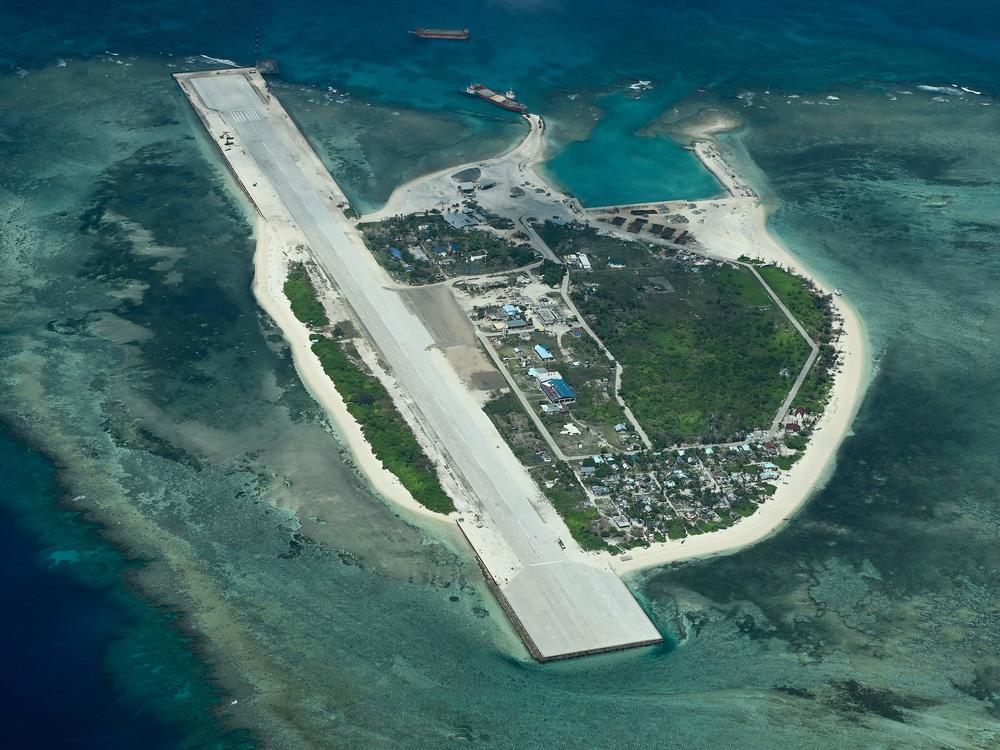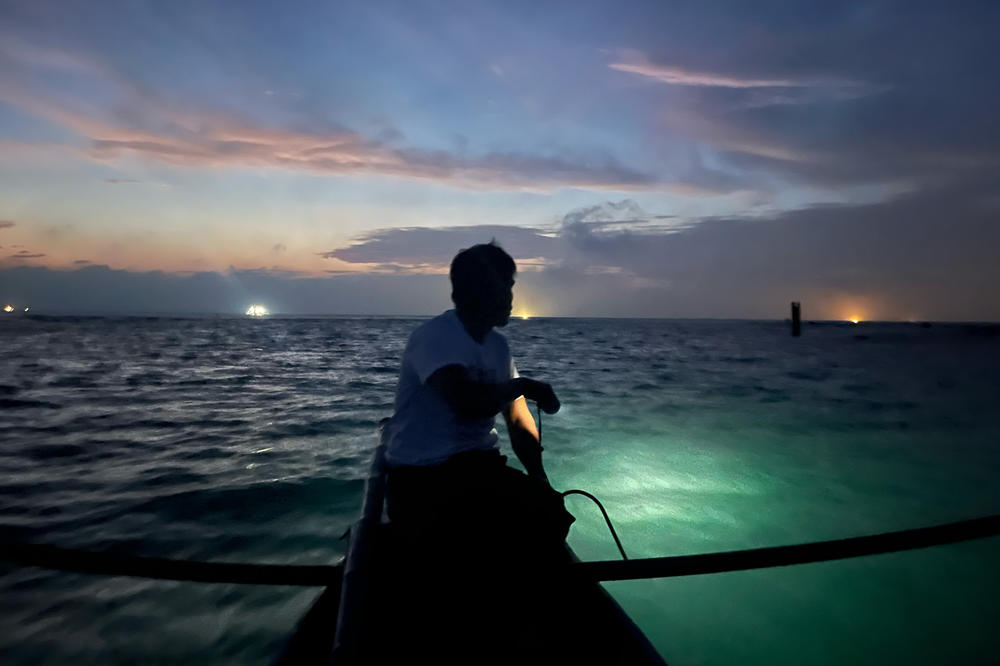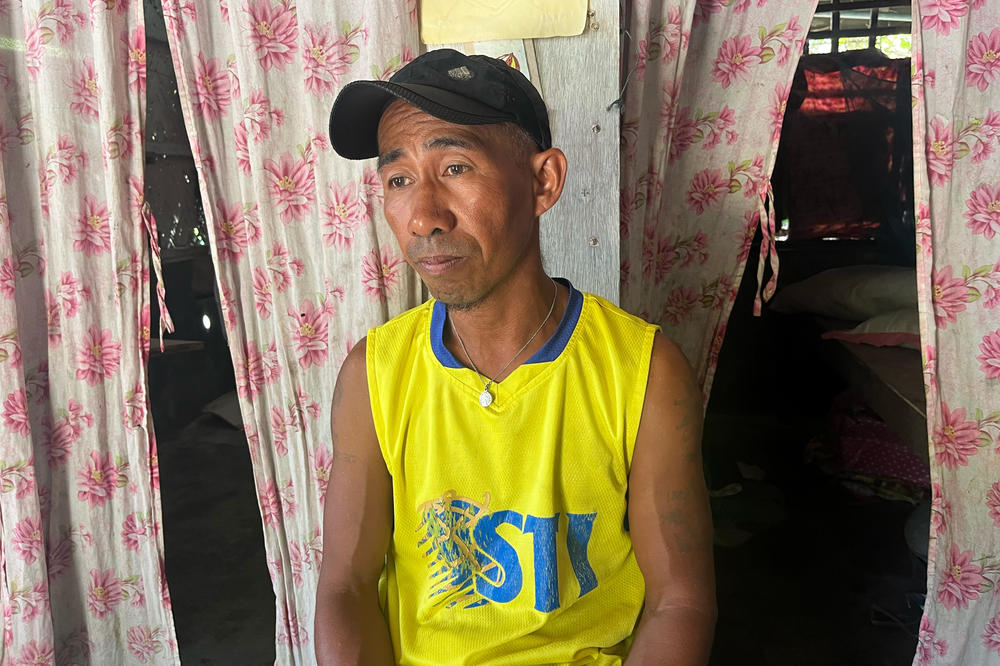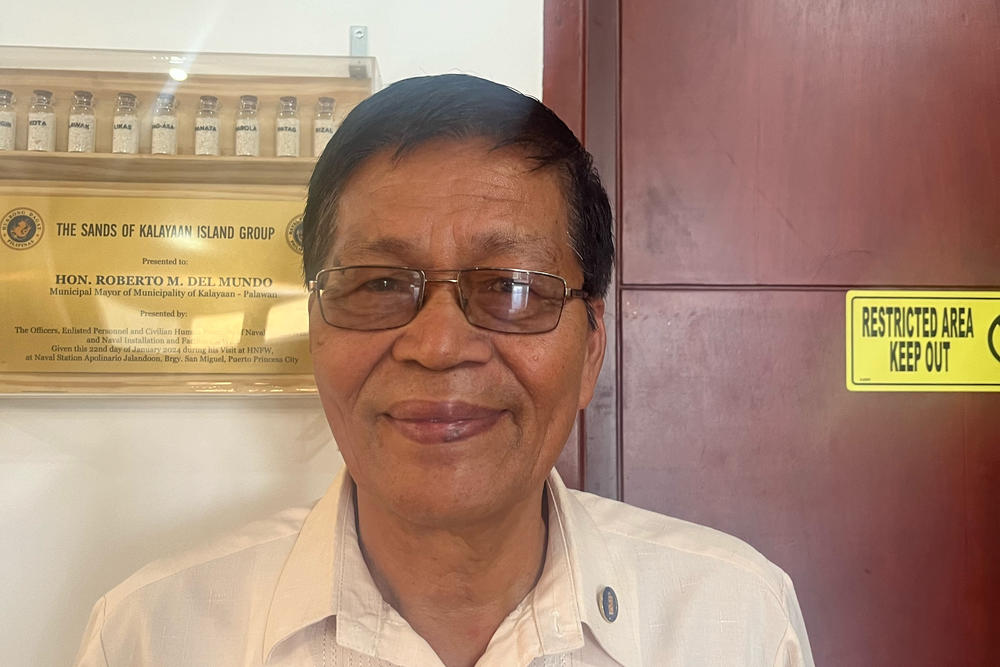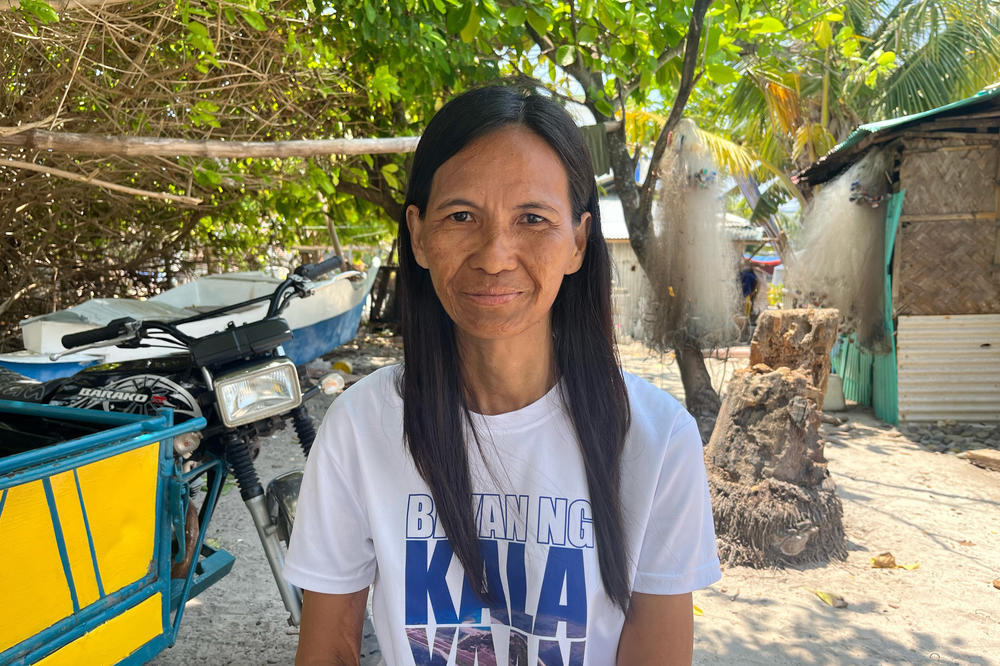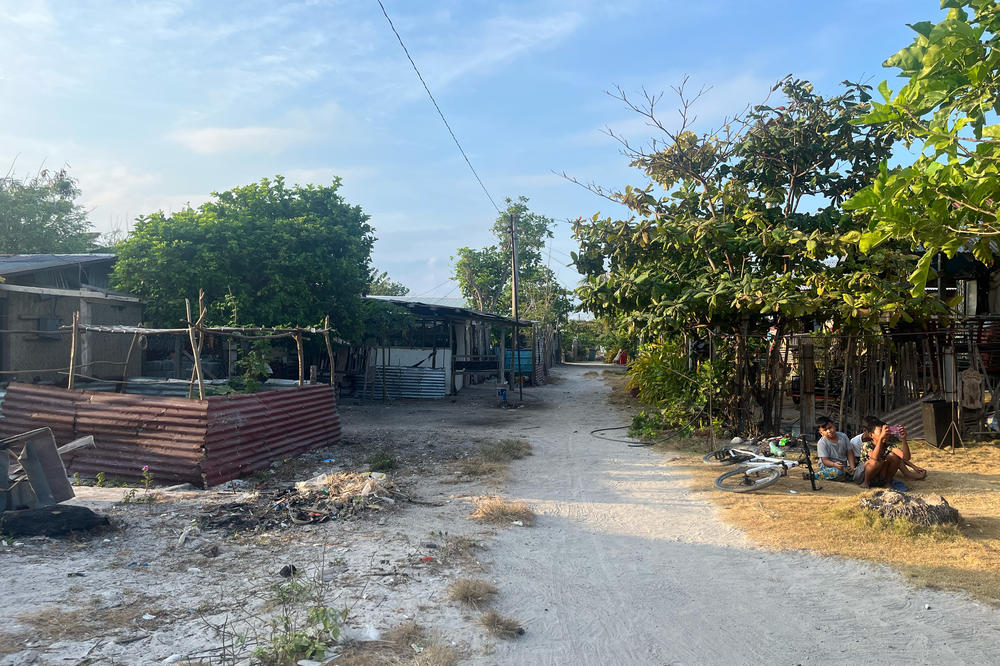Section Branding
Header Content
On a remote island, a test of wills between the Philippines and China
Primary Content
THITU ISLAND, South China Sea — Life is simple here, the residents of this tropical island like to say, except for one constant nuisance: China.
From dawn to dusk, Chinese coast guard ships sail around the island, tailing Philippine vessels nearby. At night, Chinese fishing vessels glow on the horizon with intensely bright lights used to attract shoals of fish.
"I get so annoyed with China, because this island is ours. But they still come close with their boats sometimes and act very aggressively," says Erwin J. Dela Cruz, an officer of the Philippine coast guard stationed on Thitu Island.
Less than a mile long, Thitu is one of the largest of the Spratly Islands in the South China Sea, some of which are no more than a sliver of exposed reef. But their diminutive size belies their strategic importance: the islands sit in the middle of rich fishing grounds and next to critical maritime trade routes.
In addition to the Philippines, Vietnam, Taiwan and Malaysia are a few other claimants of the islands and the territorial waters around them. However, China is by far the main territorial competitor and claims nearly all the waters in the South China Sea, despite a 2016 international tribunal ruling in the Hague that rejected nearly all of its claims.
China's claims are now spurring neighboring countries to bolster regional security partnerships. Philippine President Ferdinand Marcos Jr. says he is planning for an agreement on security and freedom of navigation in the South China Sea with President Biden and Japanese Prime Minister Fumio Kishida at a White House summit Thursday.
This past Sunday, the Philippines, the United States, Australia, and Japan also held a joint patrol around the Spratlys. China countered with its own maritime patrol.
Since the early 2000s, China has been expanding rocky reefs and sand bars that speckle the waters of the South China Sea in order to strengthen its claims over the waters that surround them. It has also deployed extensive coast guard and fishing fleets to chase off challengers.
In recent months, these standoffs between China and the Philippines have become even more pitched, particularly around a submerged reef called Second Thomas Shoal. On multiple occasions, Chinese coast guard ships shot high-pressure jets of water at Philippine resupply boats, and last December and early March, boats from both countries have collided near the shoal.
Enter Thitu — an island that the Philippines calls Pag-asa, while China calls it Zhongye. It is the only civilian-inhabited island of the Spratlys, and its approximately 250 full-time residents see their quiet existence as both an escape and an act of resistance. By continually occupying the spit of sand, they hope to keep it in the hands of the Philippines.
"[China] really wants to take the island but there is just one problem for them: We are here, the civilians are here. So that is a big obstacle for them. They will violate human rights," says Larry Hugo, a fisherman who lives on the island.
A sea stirred by geopolitics
Hugo, 45, says he prefers to spend most of his time on the water in good weather rather than on land.
From his perch on his small boat, he has had a front-row seat to the geopolitical tensions that have transformed the waters around Thitu.
Like most of the island's residents, who have resettled from other parts of the Philippines, Hugo is originally from Palawan province. When he first moved to Thitu in 2009, encroaching Vietnamese fishing boats were their biggest headache, he and others interviewed by NPR say. Hugo accused the Vietnamese of using cyanide to kill and harvest fish, poisoning and killing off coral reefs that once ringed the island.
Later, Chinese fishermen also began plying Thitu's waters, occasionally hauling off live corals and endangered giant clams. The destruction in reef habitats have led fish stocks around Thitu to drop by more than two-thirds in numbers since 1993, according to the Philippines' Kalayaan municipal government, which oversees Thitu.
In 2011, the Chinese coast guard began sailing near the island, sometimes chasing off Thitu fishermen who came too close to their vessels, residents say. Hugo started filming the Chinese boats with his cellphone.
In 2014, he shared videos showing the construction of Subi Reef, a small sandbar China has expanded to allow boats to dock and built buildings on. Hugo alerted the Philippine navy but did not receive the response he expected: "The Philippines government told me to stop sharing these videos on social media because they said it could damage Manila's friendship with China," he says.
Since then, the Philippines' more China-friendly policies under the previous government have done an about-face under the country's current President Marcos, who has made defending Manila's territorial claims of the Spratly Islands a priority.
"The Filipinos had the gumption to say, stop, and we're not going to allow this anymore," Philippine Defense Secretary Gilberto Teodoro told NPR in March. "Who believes that China has indisputable sovereignty over the whole of the South China Sea by way of history? Nobody except them."
In 2021, Hugo posted another video of the Chinese coast guard blocking his boat. It went viral.
"I am happy the [Philippine] government is now doing what it should," Hugo says.
China has repeatedly said the Philippines has no legitimate claim to the island it calls Zhongye, nor to other Spratly land features or the waters around them. China says it is blocking Filipino resupply boats because they are carrying construction materials, not food.
To counter the Chinese presence, the Philippines built a new coast guard station on Thitu last year. Its air force and marines also sent more officers to the island to serve two-month stints patrolling the waters and keeping tabs on Chinese vessels.
The island changed hands through history
Life on Thitu has the feeling of tropical Jamestown or a moon colony — a splinter community trying to replicate a new society, under hostile conditions.
Only until last year did the local government install 24/7 electricity and pave Thitu's main road with concrete. Most families live without running water. Almost no native vegetation grows on the island, so residents rely on resupply boats that arrive every few months. The nearest town, in Palawan, is at least a 30-hour boat ride away, in good weather.
Only the very patient and hardy stay long on Thitu.
Thitu and its nearby reefs, islands and atolls have been claimed many times over by competing colonial powers and geopolitical rivals. In the 1930s, the French and the newly established Republic of China verbally sparred over control of them. In the 1950s, Thitu was briefly declared free land by Tomas Cloma, a Filipino entrepreneur, before being occupied by the Republic of China, which now governs Taiwan.
Briefly imprisoned, Cloma was forced to sell his rights to Thitu to the Philippine government, which then occupied Thitu from 1974 to the present day. The first permanent residents started arriving in the mid-1990s.
"Sometimes I was sad, sometimes very lonely," says Judy Masagnay, a local government employee who was assigned to the island in 1997, one of only seven people residing on the island then.
In 2002, the Philippines began recruiting civilians to live full-time on the island to strengthen its territorial claim. It offered subsidies for free food and water to entice families. But there is no getting around the fact that there is very little to do on Thitu; circumnavigating it on foot takes only about 40 minutes.
"Drink!" fisherman Gerald Fernandez says, laughing, when asked what he does in his free time. The strains of a raucous beer-fueled karaoke session filter through the small island on a Wednesday evening, though they must turn off the speakers by the 10 p.m. nightly curfew.
Roberto Del Mundo, the mayor of Kalayaan municipality, which includes Thitu, says relations with China were quiet when he began his air force posting on the island in 1987. Now he is pessimistic about the prospect of Chinese-Filipino relations.
"I think it will come to war," Del Mundo says. "Maybe tomorrow or next year."
China has also threatened military aggression against what it sees as foreign meddling in its backyard.
"If the concerned parties intend to escalate tensions in the South China Sea and undermine China's territorial and sovereign integrity, then they will become the [People's Liberation Army's] target," a Chinese state-run tabloid declared this week, after sending a naval and air force patrol in disputed waters.
"Naturally, we have no pretensions to sparking conflicts or whatnot," Defense Secretary Teodoro said to NPR about China in March. "However, when that big thing tries to try to lay claim to territory of a smaller, proud nation whose future generations' survival depends on its ability to explore and exploit what is within its rights under international law ... we will stand up."
Plans to grow, but land and resources are limited
The Philippines is kicking it up a notch in its quest to make the island it calls Pag-asa fully Filipino: It wants to make it a utopian getaway for intrepid tourists.
"Civilianize the place, contrary to militarization," says Ken Hupanda, a Kalayaan tourism employee who wants to launch more regular boat tours to the Spratlys. He is also planning to hold a sea urchin eating contest to help rebrand the island this May. "We believe the only effective way to manage this area of the Philippines is to put more civilians [here]."
In the last decade, the Philippines has also tried to make Thitu more family-friendly, filling in an eroding airstrip and building a health center, while subsidizing more teachers for the more than 80 school-age children who live full time on the island.
"The [Philippine] mainland can be three days by boat away, so if something happens, you need to be able to make your own decisions here," says Nasreen H. Guarin, the resident midwife, who also works as a dentist, nutritionist and sometimes pediatrician for the island.
The conditions are rudimentary enough that pregnant women are advised to carry their babies to term on the Filipino mainland. Only two children are known to have been born on the island — including the fourth child of resident Leah Valdez Natural, who says she was too busy to step away from her work trying to grow dragonfruit on Thitu during her pregnancy.
Now 50, Valdez Natural says she wants to live out the rest of her days on Thitu. "We stand for the West Philippines Sea. As a Filipino, not as a Chinese community. We are Filipino community. That's why we need to develop it for [the] Philippines," she says.
China is also doubling down on its presence in the Spratlys. It has spent much of the last decade fortifying its toehold in the region. Del Mundo, the mayor, says China is also building three more artificial sand bars near Thitu.
Yet the Filipinos are not going anywhere. Enticed by the subsidies of free rice and water, more families are clamoring to move to the island, which the municipal government estimates can only sustain a maximum of 350 people, due to land and water constraints. Construction workers stationed on the island say they have been tasked with building more houses and creating a sheltered port to accommodate bigger ships.
This Easter, the island brought in a Catholic priest and held its first-ever Mass. The coast guard hosted a dinner for residents and played acoustic guitar to entertain residents, one of the efforts to normalize life on the island.
"I want to live forever if I am strong. But if my body becomes weak, I will return to the mainland because Pag-asa does not have a cemetery," laughs Hugo, the fisherman.
Bottom Content

